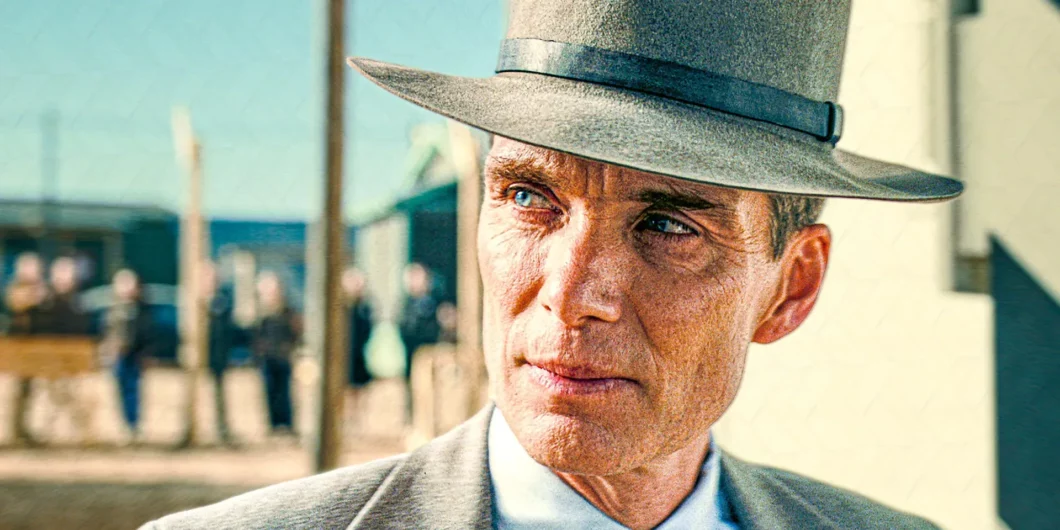Christmas in Connecticut is a comedy that explores the meaning of being an independent and single woman.
Bringing Fire from the Gods
The unbilled star of the film Oppenheimer is a metal monster named Gadget. Hoisted to the top of a spindly tower in a New Mexico desert, Gadget resembles a heavy-plated diving bell bristling with cords and wires. Its creation required three years, $2.2 billion, and the labor of 130,000 workers. Gadget’s hulking ugliness belies its extraordinary power. If Gadget works as designed, conventional explosives packed within it will detonate, compress plutonium in the center, and produce a fission chain reaction.
If it works. Viewers know, of course, that it does—the successful test, known as Trinity, early on the morning of July 16, 1945, ushers in the nuclear age and makes possible the use of two atomic bombs to end the war with Japan. Our foreknowledge of the outcome does not diminish the dramatic tension of director Christopher Nolan’s meticulous, transfixing recreation. A hard rain falls the night before, threatening to scuttle the test. Observers—most prominently, the scientists who designed and built Gadget—lay prostrate in neat rows, clutching rectangles of smoked glass to shield their eyes. A few sit in automobiles, as if waiting for a drive-in feature to start, while one scientist slathers his face with sunscreen and slips on dark glasses. The apparent bravado cannot mask the nervous energy pulsing through every observer.
Although the odds of Gadget’s explosion igniting the world’s atmosphere have been calculated at “near zero,” one man with a sense of gallows humor solicits bets on this happening. As the countdown finishes, a nervous hand quavers over a red button as the soundtrack blares a jagged, string-driven riff. At the instant of detonation, the near-deafening music halts. The sudden silence enhances the beauty and horror of the blast—blinding light, enormous clouds of red, orange, and black—as well as the scientists’ joy and dread at what they have unleashed. “I am become death, the destroyer of worlds,” J. Robert Oppenheimer whispers, quoting the Bhagavad Gita.
The test scene is spectacular, but the sustained drama in Oppenheimer comes from its vivid, sensitive depiction of the life and travails of the bomb’s most vital architect. To adapt Kai Bird and Martin J. Sherwin’s Pulitzer Prize-winning biography of Oppenheimer, American Prometheus, Nolan makes a daring narrative choice. He centers the story around Oppenheimer’s 1954 closed hearing before a security board of the Atomic Energy Commission (AEC). Despite Oppenheimer’s undisputed accomplishments, his prior associations with communists (which were well-known in 1942, when General Leslie Groves, the military director of the Manhattan Project, recruited him) have made him a target of powerful anti-communists at the height of the Red Scare.
The hearing, held in a cramped, nondescript office, sets up numerous, lengthy flashbacks, starting with Oppenheimer’s time as a troubled, brilliant young man studying physics in England and Germany. Oppenheimer’s greatest nemesis is the AEC’s former chairman, Lewis Strauss, who is shown appearing at his own hearing, before the Senate, as Dwight D. Eisenhower’s nominee to serve as the Secretary of Commerce. Shot in black and white, this hearing also prompts flashbacks that reveal how Strauss’s adulation of Oppenheimer curdled into loathing. (Though the use of black and white for these scenes initially seems hokey, in fact, it’s an efficient device to distinguish the two men’s points of view.)
The danger of these storylines is the inherent tedium of the hearings themselves. Senators posture and preen, trying to make Strauss squirm as the press records everything, while Oppenheimer’s chief inquisitor Roger Robb (Jason Clarke), huffs and blusters as he hurls one accusation after another; but these moments cannot mask the dreariness of such affairs, in which the main props are thick binders of documents, microphones, coffee cups, and ashtrays.
Fortunately, Nolan has cast wisely. The bureaucratic settings recede as the film’s stars settle into their roles. Robert Downey, Jr., as Lewis Strauss, brilliantly depicts the former shoe salesman’s suave manners, egotism, and ambition. Strauss’s animus toward Oppenheimer comes from a Congressional hearing about atomic energy during which the scientist derides his boss’s uninformed statements about isotopes. Downey screws his lips into a terse smile and briefly ducks his head, restraining his fury. As villains go, Strauss seems harmless at first, but as his confirmation hearing drags on, his recollections of Oppenheimer take on an ominous tone. His temper is always in check, but Downey deftly uses mundane gestures to capture Strauss’s impatience and vindictiveness. When he cinches his tie after a lunch break, it’s as if Strauss is tightening a noose around Oppenheimer’s neck.
Cillian Murphy so thoroughly inhabits the character of Oppenheimer that viewers are excused for believing the scientist has come back to life to play himself. Cillian’s smoothly planed face here appears weathered, even craggy, like Oppenheimer’s, and his piercing blue eyes miss nothing. The pressures on Oppenheimer, once he agreed to head the Los Alamos facility in New Mexico, were relentless and profligate, a veritable chain reaction of crises and demands.
Indispensable scientists and mathematicians squabble and threaten to quit; the churlish Edward Teller tries to walk off the base. (Oppenheimer coaxes him to stay by promising to let him exclusively research the “Super”—a proposed thermonuclear weapon that would use a fission bomb as its trigger.) General Groves, gruffly played by Matt Damon, berates Oppenheimer for traveling off the base, security officers hound his every move, and his wife Kitty drinks too much. Murphy conveys Oppenheimer’s stress with gentleness and precision. Frequent close-ups show his eyes darting nervously or his hands striking a match to light a cigarette. Oppenheimer was a man of many contradictions—aloof and affectionate, cautious and reckless, pragmatic and idealistic—and Murphy’s understated, measured performance presents Oppenheimer in all his complexities.
Did Oppenheimer’s dalliances with communism or his outspoken views on the control of nuclear weapons cause his fall?
Murphy’s and Downey’s performances are enhanced by Nolan’s command of historical detail and his eye for adding juicy dramatic touches. As a student, Oppenheimer did poison a tutor’s apple, a reckless act that almost got him expelled. In the film, Murphy rushes back to the classroom in the nick of time to prevent the visiting Niels Bohr from taking a bite. Having Oppenheimer’s girlfriend order him to translate Sanskrit (as they make love) allows us to hear, long before the Trinity test, Oppenheimer’s famous quote from the Bhagavad Vita. Oppenheimer liked to daub martini glass rims with honey and lime juice, a flourish Nolan cannot resist showing us. Did President Harry Truman (Gary Oldman) mockingly wave a white handkerchief when Oppenheimer confided that he felt he had blood on his hands after the atomic bombing of Japan? No matter—the scene chillingly shows Truman’s documented distaste for the scientist’s sensitivity. (The president told his staff to never let Oppenheimer into his office again.)
The film is notably lacking in female characters. To be sure, Los Alamos was a male-dominated environment and women, even those who helped build the atomic bomb, were prohibited from observing the Trinity test. But Oppenheimer had many strong, vibrant women in his life. Florence Pugh is excellent as Jean Tatlock, Oppenheimer’s girlfriend during his years teaching in Berkeley (and his mistress while he’s married), but the role is mostly limited to tempestuous scenes in which the couple fight and make up. The tragedy that befalls Tatlock merely serves as a backdrop for Oppenheimer to curl up in self-pitying grief. Emily Blunt, who is entrancing as Oppenheimer’s wife Kitty, rousts him with a scathing declaration: You don’t get to sin, she tells him, and then expect everyone to feel sorry for you. As it becomes painfully obvious that the fix is in at the AEC hearing—the board will rescind Oppenheimer’s security clearance—Kitty exhorts him, not for the first time, to fight back. Where Oppenheimer is quiescent and meek, even shaking hands with Teller after he delivers a damning assessment of Oppenheimer’s leadership at Los Alamos, Kitty is steely and combative, refusing to be cowed by Robb’s bellicosity. As she spars with him, effortlessly swatting away obtuse questions, we can’t help but wonder: Why have we waited so long to see her on the front line?
The film’s efforts to dramatize the ethical quandaries of the atomic bomb project occasionally fall flat, marred by soap box-like dialogue, while the flashbacks featuring the American communists in Oppenheimer’s pre-war academic milieu rely on fuzzy Marxist slogans to explain themselves. But no sloppiness is evident in the film’s engrossing exploration of Oppenheimer’s dual torment, the first coming from his profoundly mixed feelings about his creation. He fervently believed the United States must build an atomic bomb before Germany did, fearing what the Nazis would do with such a weapon. But once it became evident the Nazis would not complete their bomb project, Oppenheimer worried that harnessing the power of the atom to save American democracy from the menace of fascism and militarism could, in the long term, spell the destruction of not just democracy but the world itself.
In a haunting scene, Oppenheimer imagines the men and women of Los Alamos, who are cheering and stamping their feet as he triumphantly announces the bombing of Japan, being annihilated themselves in a nuclear holocaust. After the war, he called for international control of atomic energy to prevent a World War III with nuclear arms. His advocacy for ending the American nuclear monopoly, as well as his opposition to the development of thermonuclear (hydrogen) bombs, brought an additional torment: ostracism and humiliation. Did Oppenheimer’s dalliances with communism or his outspoken views on the control of nuclear weapons cause his fall? Or was Lewis Strauss singularly responsible? The film abjures an easy answer, trusting and challenging viewers to come to their own conclusions.



